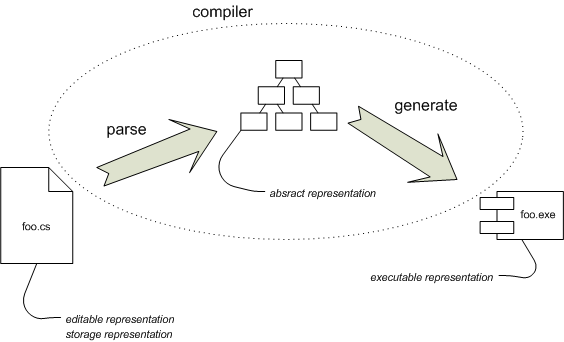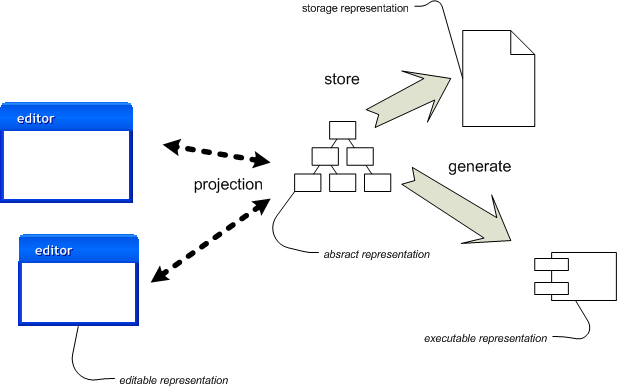Projectional Editing
14 January 2008
An alternative to SourceEditing is the idea that the core definition of a system should be held in a model and edited through projections.
To talk about this style of environment I find it handy to think in terms of multiple representations of the system:
- editable representation: what you edit in order to change the system.
- storage representation: the persistent record of the system definition.
- executable representation: what is executed to make the system run - the executable.
- abstract representation: used to manipulate and reason about system definition.
- visualization representation: a non-editable view of the system definition.
Source code combines the editable and storage representations. It executes the source by transforming the source into an executable representation either in one observable step (interpretation) or multiple steps via a compiler. In order to do this it usually transforms the source into an abstract representation as an intermediate step, but this abstract representation is transitory and only around during compilation. The source is seen as the core definition of the system.

With projectional editing the abstract representation is the is core definition of the system. A tool manipulates the abstract representation and projects multiple editable representations for the programmer to change the definition of the system. The tool persists the abstract representation in a storage representation, but this is entirely separated from any of the editable representations that it projects. The relationship to the executable representation is pretty much the same - the executable is produced through a series of transformations from the abstract representation.

An important difference between source and projectional editing environment is the split between persistent storage and editing. Projectional editing systems can choose any persistence mechanism that they choose, while source systems need to have some universal storage mechanism - which is why they are almost always text files.
The abstract representation may be edited through multiple projections, each projection can show a limited amount of the total information which isn't tied to the actual structure of the abstract representation. Projectional editing thus usually displays a wider range of editing environments - including graphical and tabular structures - rather than just a textual form.
Sophisticated source based IDEs also show multiple projections - for instance a side pane showing a list of methods for a class with graphical annotations to indicate their AccessModifiers. However these projections are usually very much secondary to a source editor, and often the projections can't be edited directly - you have to change the source and see the projection update.
Such PostIntelliJ IDEs do this by creating an abstract representation when they load the source files (which is why they can take a while to start up). They also use the abstract representation to do perform lots of other code-assistance features such as contextual code completion and refactoring.
A significant pragmatic problem with projectional editing is the fact that there is no generally accepted format for the storage representation. The fact that programmer-readable text is the universal choice for source files means that a whole slew of tools can be built to process them: editors, source-code control, difference visualizers etc. Projectional systems have to do all this themselves, which is often why these things are often lacking. In particular many projectional environments suffer greatly because they don't have a decent configuration control system, which makes it much harder for multiple people to collaborate on the same system definition. This is a big contrast to source environments that have a plethora of source code control systems to do this task.
Projectional based systems are closely connected with ModelDrivenSoftwareDevelopment, although I don't think the two are entirely synonyms. In an MDSD context the abstract representation is usually referred to as the model. Certainly almost all MDSD tools are repository based, but many all repository based tools, eg Microsoft Access, would not consider themselves to be MDSD.
(I first explored this way of looking at environments in my essay on Language Workbenches. I've described it here because I think the notion of projectional environments is broader than just in Language Workbenches.)

